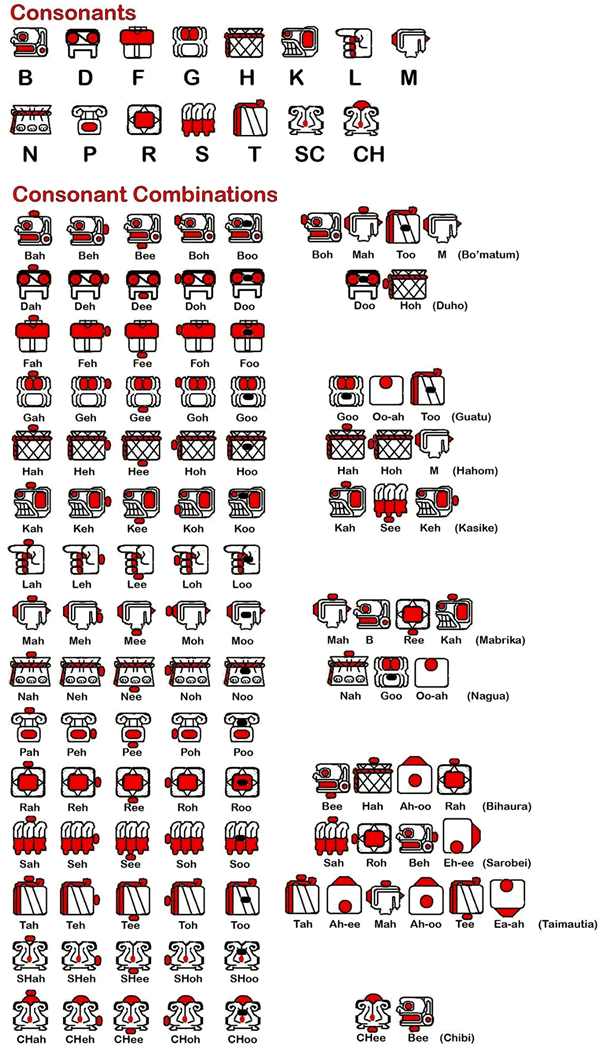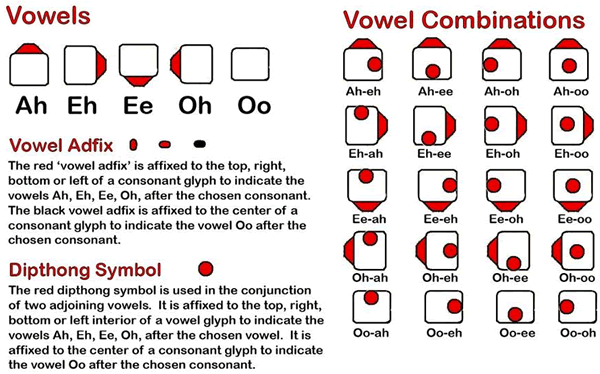The Taino Syllabary was invented by Miguel A. Sague Jr. Sobaoko Koromo (Black Ribs) to write Taino, the extinct language of his Caribbean ancestors, the Taino people of Cuba, Puerto Rico, Dominican Republic, Haiti, Jamaica and the Bahamas.
Taino was an Arawakan language related to languages spoken widely by indigenous people of the Amazon and the Orinoco river region of South America, which is the origin place of this tribal family from whence these people first spread out into the Caribbean and colonized the islands about two to three thousand years ago.
These people eventually came into contact and fell under the cultural influence of the Maya civilization after they settled in Cuba which is very close to the Yucatan Peninsula of the Mayas in Mexico. As a result the ancient Taino adopted a number of Meso-American habits and customs that are obviously of Central American and Mexican origin. The ancient Meso-American indigenous people were fully literate and especially the Mayas had a complete syllabary with which they could express sophisticated ideas including abstract concepts.
The ancient Taino never reached the level of literacy that their Maya neighbors did, but Miguel believes that given more time, if their land had not been conquered and their culture destroyed by the Spanish followers of Christopher Columbus, they would eventually have adopted elements of the Maya glyphic system and would have evolved a written language of their own.
Miguel currently participates in a resurgence movement that seeks to revive as much of the lost culture and tradition of his Taino ancestors. There are thousands of resurgent Tainos both on the islands and in the diaspora (mostly in the United States) who have embraced this movement and hope to bring back the glory of the old ways, and adapt it to the modern age. Language plays a very important part of this recovery process and many modern Tainos hope to resurrect the old tongue from the millions of old Taino words (mostly nouns) that have survived and have been adopted into the local Spanish, English and French dialects of the Caribbean.
He feels that this process of language recovery would be better served if he and his compatriots would have a native script with which to express the language instead of struggling with the badly adapted and awkwardly-spelled Taino words written in the Latin script of Spanish, French and English.
Miguel has studied the way that ancient Maya script works and has borrowed some of the strategies used by the ancient Maya to render sounds in visible form. He has adapted some of those strategies to the Taino language, using images taken from archeological material of the Caribbean islands and has created a number of glyphs to represent the consonants of the ancient Taino language.
Then in a manner similar to that used by the ancient Maya he has created a system by which these consonants can be expressed preceding the five basic vowels of the Spanish alphabet which are also the five basic vowels of the ancient Taino language as we know it. The system expresses these consonant-vowel blends by attaching a "vowel-knob" to the consonant glyph. The position of the vowel-knob denotes which vowel is being sounded after the consonant (above the glyph for the "ah" sound, to the right of the glyph for "eh" sound, below the glyph for the "ee" sound, to the left of the glyph for the :oh" sound and at the center of the glyph for the "oo" sound). For example, the "B" consonant glyph with a vowel-knob affixed on the left side expresses the sound "Boh".



Daka naboria Yaya.
I am a servant of the Great Spirit.
Information about Taino | Phrases (in Taíno-Quisqueyanaíqui)
Constructed scripts for: Ainu | Arabic | Chinese languages | Dutch | English | Hawaiian | Hungarian | Japanese | Korean | Lingala | Malay & Indonesian | Persian | Tagalog / Filipino | Russian | Sanskrit | Spanish | Taino | Turkish | Vietnamese | Welsh | Other natural languages | Colour-based scripts | Tactile scripts | Phonetic/universal scripts | Constructed scripts for constructed languages | Adaptations of existing alphabets | Fictional alphabets | Magical alphabets | A-Z index | How to submit a constructed script
[top]
You can support this site by Buying Me A Coffee, and if you like what you see on this page, you can use the buttons below to share it with people you know.

If you like this site and find it useful, you can support it by making a donation via PayPal or Patreon, or by contributing in other ways. Omniglot is how I make my living.
Note: all links on this site to Amazon.com, Amazon.co.uk
and Amazon.fr
are affiliate links. This means I earn a commission if you click on any of them and buy something. So by clicking on these links you can help to support this site.
[top]